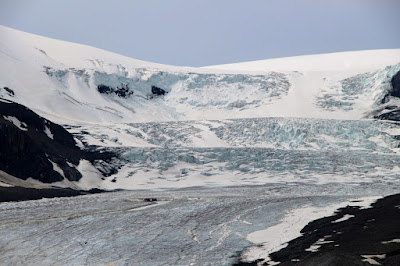 We finally made it into the land of our northern neighbor, for a wonderful two-week stay in Banff National Park, Alberta. Getting there through British Columbia from the west was a glorious 6-hour drive from Vernon BC through orchards, vineyards, and agriculture that lined miles and miles of rivers and lakes that themselves wound through valley after valley flanked by rugged granite mountains. At last the agriculture gives way to forests and stupendous mountain views in every direction. Here are the Canadian Rockies, still melting their snows in June, grand sentinels of time and change.
We finally made it into the land of our northern neighbor, for a wonderful two-week stay in Banff National Park, Alberta. Getting there through British Columbia from the west was a glorious 6-hour drive from Vernon BC through orchards, vineyards, and agriculture that lined miles and miles of rivers and lakes that themselves wound through valley after valley flanked by rugged granite mountains. At last the agriculture gives way to forests and stupendous mountain views in every direction. Here are the Canadian Rockies, still melting their snows in June, grand sentinels of time and change. We landed in Banff at the beginning of a record heat wave, with temps in the mid 80s drawing out every local to enjoy the sunshine amid busloads of early-season tourists. We avoided most crowds by touring earlier in the day, and packed most of our touring into the first three days to take advantage of the weather. The second week of our stay brought lower than average temps, with mid 40s and some very wet rain for several days, which also gave the nearby mountains a fresh coat of snow. One morning we even had the lightest of snow flurries at campground level...dandruff from the gods filtering through sunshine.
This region must be experienced first hand to be fully appreciated, but here are a few highlights of the trip.
 |
| On the way to Banff from Vernon, still in British Columbia...an inkling of what the Canadian Rockies have to offer. |
 |
| A spate of rain near Alberta had us driving through rainbows for fifteen minutes. |
 |
| Our RV spot for most of our stay in Banff. |
 |
| The world-famous Banff Springs Hotel, the first hotel in the area, built by a railroad baron to draw upper-class crowds, and the humble beginnings of all that is Banff today. |
 |
| The upper falls at Johnston Canyon, end of the trail. |
 |
| The far end of the lake. The sign warns of snow avalanches, an irony on a day so hot that people are in shorts and swimsuits on this beach. |
 |
| The Lake Louise Hotel, long-lake view. |
 |
| Past the end of the lake, the trail turns more rugged and goes for many miles into the backcountry. People ahead on the trail are tiny specks! |
 |
| It also offers lovely views looking back at Lake Louise and its valley. The mountain at the far end is the ski resort, where I later took a gondola ride. |
 |
| A closer view of glacier and 40+ feet of snow that continues to send water into the lake. |
 |
| I couldn't find what kind of flower this is, but it's less than an inch long. Double-click, and you'll find a little green cricket-like fellow peeking out from under the red rim. |
 |
| To round out the bear experience--two of several grizzlies that regularly hang out under the Lake Louise gondola run, seen on the way down. Three of them were out for a sunny munch. |
 |
| It was extremely weird seeing a grizzly graze like a cow. |
 |
| The side of Mt Rundle that's most visible from the TransCanada Highway and Banff Springs Hotel. |
 |
| We arrive at the Columbia Icefields, which is about halfway to Jasper, and within the boundaries of Jasper National Park. |
 |
| A quick orientation using the interpretive map at the visitor center (yellow marker), showing the Athabasca Glacier (orange marker) and Dome Glacier (blue marker). |
 |
| Dome Glacier flows in a narrower space between mountains, looking chunky and rough. |
 |
| The toe of the glacier used to be here in 1982. Notice the people in the background. They still haven't made it to the glacier's edge. |
 |
| An ice cave formed by collapsing ice in the face of that gritty black surface in the previous photo. All that glacially-moved surface gravel is hiding ice that is spectacularly blue. |
 |
| To the east, another mountain (Mount Girouard?) looked like it was spewing lava. |
 |
| And everywhere I looked grew the wild rose of Alberta, the province's official flower, happily blooming amid green forests and gray stone. |


























